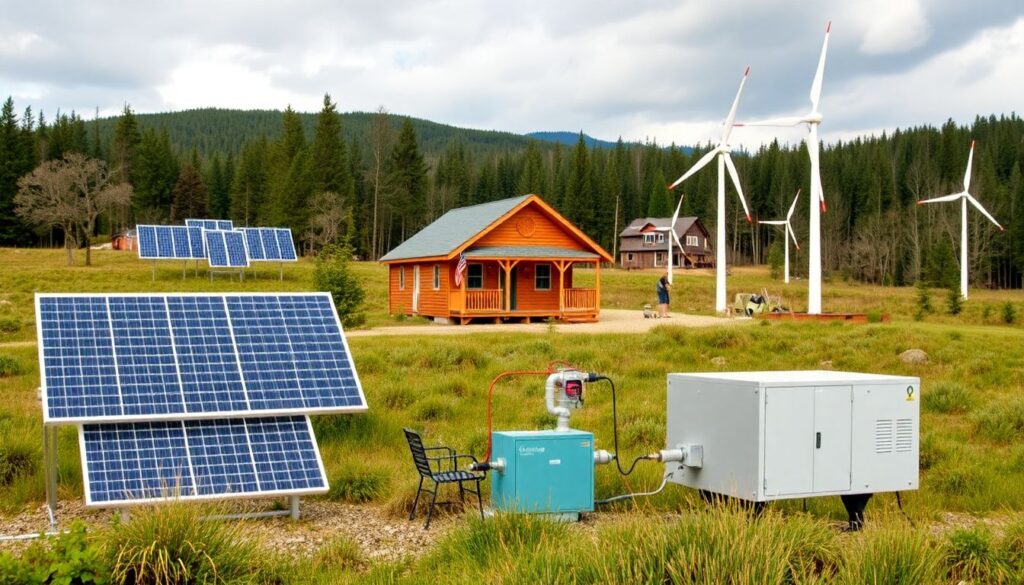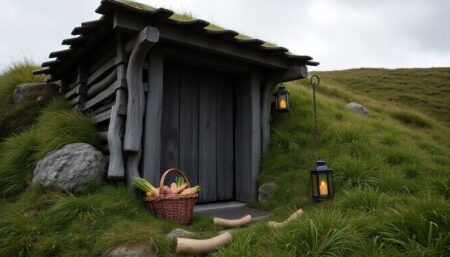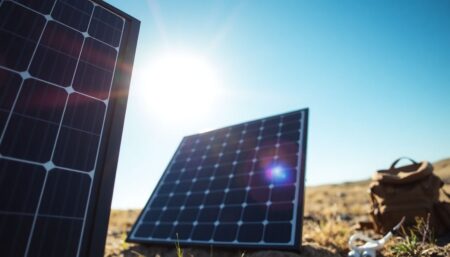Have you ever wondered how you could power your home, workshop, or even a remote cabin without relying on the traditional power grid? The idea of generating your own electricity, off-grid, might seem like a daunting task, but it’s not only possible, it’s also becoming increasingly popular and accessible. Welcome to the world of DIY off-grid power generation, where sustainability meets self-reliance, and where you, the reader, are about to embark on an exciting journey towards energy independence.
According to a study by the International Energy Agency, the global off-grid solar market has grown exponentially in recent years, with over 420 million people gaining access to electricity through off-grid and mini-grid systems. This trend is not just about numbers; it’s about people like you and me taking control of our energy needs, reducing our carbon footprint, and preparing for potential grid failures or natural disasters. But where do you start? That’s where this article comes in.
In this comprehensive guide, we’re going to explore the fascinating world of DIY off-grid power systems. We’ll delve into the basics of off-grid power generation, discuss the benefits of sustainable energy, and guide you through the process of designing and implementing your own off-grid electricity solution. By the end of this article, you’ll have a solid understanding of the technologies involved, the steps required to set up your own system, and the confidence to take control of your energy future.
So, let’s agree that relying solely on the grid for our power needs is not always the best or most sustainable option. We promise to provide you with a detailed, step-by-step guide that demystifies off-grid power generation. And here’s a preview of what’s to come: we’ll explore renewable energy sources like solar, wind, and hydro power, discuss energy storage solutions, and provide real-life examples and case studies to illustrate our points. Are you ready to take the first step towards energy independence? Let’s dive in!
Harnessing Sustainable Energy: A Comprehensive Guide to DIY Off-Grid Power Generation
In the quest for energy independence and a greener planet, harnessing sustainable power has never been more crucial. This comprehensive guide, ‘Harnessing Sustainable Energy: A Comprehensive Guide to DIY Off-Grid Power Generation’, is your roadmap to self-sufficiency, empowering you to create your own electricity without relying on traditional power grids. Imagine the freedom of generating your own power, reducing your carbon footprint, and even selling excess energy back to the grid! This isn’t just about saving money; it’s about taking control of your energy future. From solar panels to wind turbines, hydroelectric systems to battery storage, we’ll delve into the world of renewable energy, demystifying complex concepts and providing practical, step-by-step instructions. Whether you’re a seasoned DIY enthusiast or a curious beginner, this guide is your key to unlocking the power of the sun, wind, and water. So, let’s roll up our sleeves, embrace the challenge, and together, we’ll generate a sustainable future, one watt at a time.

Understanding Off-Grid Power Generation
Off-grid power generation, a concept that has gained significant traction in recent years, refers to the production of electricity independent of the traditional power grid. This is achieved through various methods, such as solar, wind, hydro, or micro-grid systems, which can be tailored to meet specific energy needs. The importance of off-grid power generation lies in its potential to provide reliable electricity to remote or underserved communities, as well as its role in promoting energy independence and sustainability.Off-grid systems differ from on-grid power systems in several ways. On-grid systems rely on a centralized power plant that generates electricity, which is then distributed to consumers through a complex network of transmission lines. In contrast, off-grid systems are decentralized, with power generation occurring at the point of use. This not only reduces transmission losses but also enhances energy security and resilience, as it is less vulnerable to disruptions caused by natural disasters or other external factors.The need for sustainable energy sources is more pressing than ever. Traditional power generation methods, which often rely on fossil fuels, contribute significantly to greenhouse gas emissions and climate change. Off-grid power generation, on the other hand, offers a clean and renewable alternative. By harnessing the power of the sun, wind, or water, off-grid systems can generate electricity with minimal environmental impact.Moreover, off-grid power generation offers numerous benefits. It can reduce electricity costs in the long run, as it eliminates the need for grid connection fees and can even allow for excess energy to be sold back to the grid. It also promotes energy independence, reducing reliance on imported fuels and volatile energy prices. Furthermore, off-grid systems can be designed to be modular and scalable, making them suitable for a wide range of applications, from powering a single home to entire communities.In conclusion, off-grid power generation is a crucial concept in the transition towards a sustainable energy future. It offers a clean, reliable, and cost-effective alternative to traditional power systems, and its potential to transform the way we generate and consume energy is immense. As we continue to grapple with the challenges posed by climate change and the need for energy security, off-grid power generation presents a promising solution that deserves serious consideration.

Assessing Your Energy Needs
Assessing your energy needs is a crucial step towards understanding your environmental impact and managing your utility bills. Let’s embark on a journey to calculate your daily energy consumption, explore the importance of energy efficiency, and learn how to prioritize essential appliances and devices.
First, let’s calculate your daily energy consumption. Grab your latest electricity bill and locate the kilowatt-hours (kWh) used in the billing period. Divide this number by the number of days in the billing period to find your daily energy consumption. For instance, if you used 900 kWh in a 30-day period, your daily consumption would be 30 kWh/day.
Now, let’s break down this consumption to understand where your energy is going. List all the appliances and devices in your home, along with their average daily energy consumption. You can find this information in the appliance’s manual or online. Here’s a simple format to follow:
- Appliance/Device: {Name}
- Average Daily Consumption: {kWh/day}
For example:
- Refrigerator: 1.5 kWh/day
- Television: 0.1 kWh/day
- Laptop: 0.05 kWh/day
- …
Understanding your energy consumption patterns is the first step towards energy efficiency. Energy-efficient appliances and devices can significantly reduce your consumption and save you money in the long run. Look for the Energy Star label when purchasing new appliances; these products meet strict energy efficiency guidelines set by the U.S. Environmental Protection Agency and the U.S. Department of Energy.
Prioritizing essential appliances and devices is also key. Identify the appliances you use daily and can’t live without, like your refrigerator and lights. These are your essentials. Next, consider appliances you use occasionally, like your oven or washing machine. Lastly, evaluate appliances and devices you can live without, such as a second refrigerator or a rarely used gaming console.
Once you’ve identified your essentials, look for ways to optimize their energy usage. For instance, unplug appliances when not in use, use energy-saving modes, or consider upgrading to energy-efficient models. Remember, every kWh saved is a step towards a more sustainable future and lower utility bills.
Assessing your energy needs is an ongoing process. Regularly review your energy consumption, update your list of appliances, and look for new ways to improve your energy efficiency. By doing so, you’ll not only reduce your environmental impact but also save money in the long run.

Solar Power: The Backbone of Off-Grid Systems
Solar power, the silent and steadfast backbone of off-grid systems, harnesses the boundless energy of our sun to provide electricity where traditional grids cannot reach. The process begins with solar panels, which convert sunlight into direct current (DC) electricity through a phenomenon called the photovoltaic effect. This raw energy is then channeled through a charge controller, a crucial component that regulates the voltage and current, preventing overcharging, and ensuring the longevity of the batteries. Batteries, the energy storage units, store this electricity for use when the sun isn’t shining, such as at night or on cloudy days.
The advantages of solar power are manifold. It’s clean, renewable, and virtually free once the initial investment is made. Solar power systems are also incredibly versatile, powering everything from small electronics to entire homes and businesses. However, they’re not without their disadvantages. The upfront cost can be high, and they rely on consistent sunlight, making them less reliable in consistently cloudy or shaded areas.
Sizing a solar power system involves calculating your energy needs and matching them with the system’s capacity. Here’s a simplified step-by-step guide:
- Calculate your daily energy consumption. This includes everything from lights to appliances to electronics.
- Determine your average daily sunlight hours. This can vary greatly depending on your location.
- Choose a solar panel with an appropriate wattage based on your energy needs and sunlight hours.
- Select a battery with enough capacity to store the energy produced by your solar panel.
- Choose a charge controller that’s compatible with your solar panel and battery.
Each of these components plays a vital role in the functioning of a solar power system, and choosing the right ones can mean the difference between a reliable, efficient system and one that’s underpowered or prone to failure.

Wind Power: Supplementing Solar Energy
Wind power, often overshadowed by its solar counterpart, is a formidable force in off-grid systems. While solar panels harness energy from the sun, wind turbines extract power from the wind, providing a complementary energy source that can maximize self-sufficiency.
Wind turbine efficiency is influenced by several factors. The most significant is wind speed. Turbines operate most efficiently in consistent, high-speed winds. Therefore, understanding your location’s wind patterns is crucial. A wind resource assessment, which measures average wind speeds over time, can help determine if your site is windy enough for a turbine.
Another factor is the turbine’s design. Horizontal-axis wind turbines (HAWTs) and vertical-axis wind turbines (VAWTs) each have their advantages. HAWTs are typically more efficient in high winds, while VAWTs can operate in lower wind speeds and are less affected by wind direction changes.
To determine if a wind turbine is a viable addition to your power system, follow these steps:
- Conduct a wind resource assessment to measure average wind speeds at your site.
- Consider your energy needs and the turbine’s capacity to meet them.
- Evaluate the cost of the turbine, installation, and maintenance, and compare it to the potential energy savings.
- Check local regulations and obtain any necessary permits.
- Consider the environmental impact and aesthetic concerns.
By supplementing solar energy with wind power, you can create a more robust, resilient off-grid system that harnesses the power of both the sun and the wind.

Hydropower: Harnessing Nature’s Energy
In the grand tapestry of renewable energy sources, hydropower stands out as a robust and reliable option, particularly for off-grid systems. By harnessing the kinetic energy of flowing or falling water, hydropower offers a clean, sustainable, and often cost-effective means of generating electricity. The possibilities are vast, ranging from powering remote communities to providing backup energy for critical infrastructure.
The key to a successful hydroelectric setup lies in understanding and meeting certain requirements. Firstly, a consistent and substantial water source is crucial. Rivers, streams, or even rainwater can be utilized, but the flow rate and volume should be sufficient to drive the turbine efficiently. Secondly, the topography plays a significant role. A significant elevation change or a high flow rate is ideal for maximizing energy production. Lastly, the system’s design should be tailored to the specific site conditions, considering factors like turbine type, generator size, and storage capacity.
However, while hydropower is a compelling solution, it’s essential to consider its environmental impact. The construction of dams and turbines can disrupt local ecosystems, affecting wildlife and water quality. To mitigate these effects, careful planning and management are necessary. This includes minimizing the reservoir’s size, preserving fish passageways, and implementing fish-friendly turbine designs. Moreover, regular monitoring and maintenance can help prevent long-term environmental degradation. Additionally, the intermittency of hydropower due to seasonal variations in water flow should be factored in, often requiring energy storage solutions or complementary renewable sources.
In conclusion, hydropower, when harnessed responsibly, can provide a steady stream of clean energy for off-grid systems. By understanding the requirements and addressing the environmental considerations, we can unlock the full potential of this natural energy source, paving the way for sustainable and resilient power systems.

Battery Storage: Powering Through the Night
In the grand symphony of off-grid power systems, batteries play a pivotal role, akin to the conductor ensuring the music never stops. They are the silent guardians that store energy harvested from sources like solar, wind, or hydro, and release it when needed, typically during nighttime or periods of low generation. This process, essentially, is what ‘powering through the night’ signifies.
The battery market is a veritable smorgasbord of options, each with its unique strengths and weaknesses. Let’s delve into a few key players:
- Lead-Acid Batteries: The workhorses of the industry, they’re robust, affordable, and widely available. However, they have a shorter lifespan and lower depth of discharge compared to other types.
- Sealed Lead-Acid (SLA) Batteries: A step up from their unsealed counterparts, SLA batteries are maintenance-free and can be used indoors without ventilation.
- Lithium-Ion Batteries: The poster child of modern technology, they offer high energy density, long lifespan, and deep discharge capabilities. However, they come at a premium price.
- Flow Batteries: These are a newer technology that uses electrolyte fluid to store energy. They’re non-flammable, have a long lifespan, and can be scaled up easily, but they’re also more expensive.
Now, maintaining these powerhouses is as crucial as choosing the right one. Here are some steps to prolong their lifespan:
- Regularly check and maintain the electrolyte levels in lead-acid batteries. Overfilling or underfilling can significantly reduce their lifespan.
- Keep batteries clean and dry. Corrosion can lead to poor performance and even failure.
- Avoid deep discharges. Most batteries perform best when they’re not fully discharged and recharged frequently.
- Store batteries correctly when not in use. Ideal storage conditions vary by battery type, so consult the manufacturer’s guidelines.
- Monitor temperature. Extreme heat and cold can degrade batteries faster, so try to keep them within their recommended temperature range.
By understanding and caring for your batteries, you’re not just investing in power, but in the ability to ‘power through the night’ for years to come.

Backup Generators: A Safety Net for Off-Grid Living
Embarking on an off-grid lifestyle, while liberating, comes with its unique challenges. One of the most pressing is ensuring a reliable power source. This is where backup generators step in, acting as a safety net, a lifeline that keeps your off-grid system humming even when the sun isn’t shining or the wind isn’t blowing. They are not just a luxury, but a necessity for maintaining comfort, safety, and self-sufficiency.
When it comes to choosing a backup generator, you’ll find a smorgasbord of options, each with its own set of pros and cons. Let’s break down a few:
- Gasoline Generators: These are the most common and typically the least expensive. They’re easy to find, easy to use, and can provide a substantial amount of power. However, they require regular maintenance, produce emissions, and have a limited run time before refueling is needed.
- Diesel Generators: These are more durable, efficient, and have a longer lifespan than their gasoline counterparts. They also produce less noise and emissions. However, they’re more expensive to purchase and maintain.
- Propane Generators: These are clean-burning, produce less noise, and can be used indoors with proper ventilation. They’re also safer to store than gasoline. However, they’re more expensive and the fuel can be heavier to handle.
- Inverter Generators: These are quieter, more fuel-efficient, and produce cleaner power, making them ideal for sensitive electronics. However, they’re more expensive and may not provide as much power as other types.
- Solar Generators: These are eco-friendly, silent, and can be used in conjunction with solar panels for a truly off-grid experience. However, they’re more expensive and rely on sunlight for charging.
- Wind Turbine Generators: These are another eco-friendly option, harnessing the power of the wind. They’re quiet, durable, and can provide a substantial amount of power. However, they require consistent wind speeds and can be expensive to install.
Choosing the right generator depends on your power needs, budget, environmental concerns, and the specific challenges of your off-grid location. It’s a decision that requires careful consideration, but with the right generator, you’ll have a reliable power source that’s ready to kick in when you need it most.

DIY Power System Design and Installation
Designing and installing a DIY off-grid power system can be a rewarding and empowering experience. It allows you to harness the power of nature, reduce your carbon footprint, and gain a deep understanding of your energy consumption. Let’s embark on this journey together, step by step, ensuring safety, efficiency, and sustainability throughout the process.
Step 1: Assess Your Energy Needs
Begin by calculating your daily energy consumption. List all your appliances and their wattage. Multiply the wattage by the hours of use to find the daily energy consumption for each. Add them up to find your total daily energy need. This will help you determine the size of your solar panels and battery bank.
Step 2: Choose Your Components
- Solar Panels: Select panels based on your energy needs and available space. Monocrystalline panels are more efficient but also more expensive.
- Battery Bank: Deep cycle batteries are ideal for off-grid systems. Calculate the total battery capacity you need based on your energy needs and the number of days you want your system to function without sunlight.
- Charge Controller: This regulates the voltage and current coming from your solar panels to prevent overcharging your batteries.
- Inverter: This converts DC power from your batteries to AC power for your appliances.
- Wiring and Fuses: Use appropriate gauge wire and fuses to ensure safety and efficiency.
Step 3: Design Your Wiring Diagram
Sketch out your wiring diagram before you start. This will help you understand how everything connects and ensures you have all the necessary components. Here’s a simple diagram:
Solar Panels → Charge Controller → Battery Bank → Inverter → AppliancesStep 4: Safety First
- Always turn off and disconnect your system before working on it.
- Use appropriate personal protective equipment (PPE), including safety glasses and gloves.
- Keep your workspace clean and well-lit.
- Never touch exposed electrical parts with wet hands.
Step 5: Install Your System
- Mounting Solar Panels: Install your solar panels in a location that gets maximum sunlight. They should be tilted at an angle equal to your latitude plus 10-15 degrees.
- Wiring: Follow your wiring diagram, ensuring all connections are tight and secure. Use heat shrink tubing and electrical tape to protect connections.
- Grounding: Proper grounding is crucial for safety. Connect your system to a grounding rod driven into the earth.
Step 6: Testing and Troubleshooting
- Once everything is connected, turn on your system and check that your batteries are charging.
- If your system isn’t working as expected, double-check your wiring diagram and connections.
- Use a multimeter to test voltage and current at different points in your system to help diagnose any issues.
Step 7: Monitor and Maintain
Regularly check your battery levels and ensure your system is functioning optimally. Clean your solar panels periodically to maintain their efficiency. With proper care, your DIY off-grid power system can provide reliable energy for years to come.Remember, safety is paramount in any electrical project. If you’re unsure about any aspect, consult a professional or seek advice from experienced DIYers in online forums.

Maintaining and Upgrading Your Off-Grid Power System
Maintaining and upgrading your off-grid power system is a crucial task that ensures your independence from the grid and maximizes your energy efficiency. Regular inspections are the backbone of this process, allowing you to identify potential issues before they become major problems. Start by checking your system’s main components, such as the solar panels, wind turbines, or hydroelectric generators, at least once a year. Look for signs of wear and tear, like cracks or corrosion, and clean them if necessary.
Next, inspect your energy storage system, typically batteries. Check their fluid levels, terminals, and connections for any leaks or damage. Ensure they’re properly ventilated and kept within their optimal temperature range. If you notice any issues, it might be time to replace them, as batteries have a limited lifespan.
Upgrading your off-grid power system can involve adding new energy sources or improving existing ones. For instance, if you’re relying solely on solar power, consider adding a wind turbine or a micro-hydro setup to diversify your energy production. This can make your system more resilient to changes in weather patterns and ensure a consistent power supply.
When adding new components, ensure they’re compatible with your existing system. You might need to upgrade your inverter or charge controller to handle the increased power output. Always consult the manufacturer’s guidelines and consider hiring a professional if you’re unsure about any aspect of the upgrade.
Lastly, keep detailed records of your system’s performance and maintenance history. This will help you identify trends, anticipate future upgrades, and make informed decisions about your off-grid power system. Regular maintenance and smart upgrades will not only extend the life of your system but also ensure it continues to meet your energy needs.
FAQ
What is an off-grid power generation system and why would I want one?
What are some common DIY off-grid power generation methods?
- Solar power: Harnessing energy from the sun using photovoltaic (PV) panels.
- Wind power: Generating electricity using wind turbines.
- Hydropower: Producing electricity from flowing water, like a stream or river.
- Micro-hydro: Similar to hydropower, but on a smaller scale, often using a water wheel or turbine.
- Micro-wind: Similar to wind power, but on a smaller scale, often used for remote or off-grid applications.
- Combined heat and power (CHP): Generating both heat and electricity from a single source, like a wood stove or biogas digester.
How do I size an off-grid power system for my needs?
- Calculate your daily energy consumption by listing all your electrical appliances and their power ratings. Multiply each rating by the average daily usage hours to get the daily energy consumption for each appliance.
- Add up the daily energy consumption of all your appliances to get your total daily energy need.
- Determine your average daily sunlight hours (for solar) or wind speed (for wind) to size your renewable energy generators accordingly.
- Choose a battery bank size that can store enough energy to meet your daily needs, considering factors like depth of discharge and battery lifespan.
- Consider adding a generator or other backup power source for cloudy days or low wind periods.
What are the key components of a DIY off-grid power system?
- Power generation: Solar panels, wind turbines, micro-hydro turbines, etc.
- Charge controller: Regulates the voltage and current coming from the generator to match the battery’s charging requirements.
- Battery bank: Stores the electricity generated by the power source for later use.
- Inverter: Converts the DC power from the battery bank to AC power for use with standard appliances.
- Wiring and fuses: Ensures safe and efficient electrical connections between components.
- Monitoring system: Allows you to track your system’s performance and energy usage.
- Backup power source (optional): A generator or additional renewable energy source to supplement your primary power generation during periods of low production.
How can I ensure the safety of my DIY off-grid power system?
- Grounding: Properly ground your system to protect against electrical shock in case of a fault.
- Fuses and circuit breakers: Install fuses and circuit breakers to protect your system and prevent electrical fires in case of an overload or short circuit.
- Wiring: Use appropriate gauge wire and follow local electrical codes to ensure safe and efficient connections.
- Battery safety: Store batteries in a well-ventilated area, away from heat sources and flammable materials. Regularly inspect batteries for leaks or damage, and follow manufacturer guidelines for charging and maintenance.
- Regular inspections: Periodically inspect your system for any signs of wear, damage, or corrosion, and address any issues promptly.
- Training: Educate yourself and your family on the proper use and safety procedures for your off-grid power system.
What are some common myths about DIY off-grid power systems?
- Off-grid systems are too expensive: While the initial investment can be significant, the long-term savings on electricity bills and increased self-sufficiency can make it a cost-effective choice in the long run.
- Off-grid systems are difficult to install and maintain: With the right knowledge, resources, and planning, DIY off-grid power systems can be installed and maintained by homeowners.
- Off-grid systems require constant sunlight or high wind speeds: Modern off-grid power systems can be designed to accommodate varying weather conditions and incorporate backup power sources to ensure a consistent supply of electricity.
- Off-grid systems are not reliable: With proper design, maintenance, and backup power sources, off-grid power systems can provide a reliable and consistent source of electricity.
How can I integrate my DIY off-grid power system with the grid?
- Check local regulations and obtain any necessary permits.
- Install a bidirectional inverter that can synchronize with the grid and safely connect your system to the grid.
- Install a revenue-grade meter to accurately measure the electricity you produce and consume.
- Connect your system to the grid through a dedicated circuit breaker and disconnect switch.
- Ensure your system can safely disconnect from the grid in case of a power outage, following local regulations and guidelines.
What are some creative ways to power my off-grid home?
- Micro-hydro: Using a small water turbine or water wheel to generate electricity from a stream or river on your property.
- Micro-wind: Installing a small wind turbine on your property to harness wind energy, even in low wind speed areas.
- Combined heat and power (CHP): Generating both heat and electricity from a single source, like a wood stove, biogas digester, or even a small-scale Stirling engine.
- Solar thermal: Using solar panels to heat water or air for your home, reducing the need for electrical heating.
- Energy-efficient appliances: Choosing energy-efficient appliances and lighting can reduce your overall power consumption, making your off-grid system more sustainable.
- Energy storage: Incorporating energy storage solutions, like flow batteries or compressed air energy storage, can help manage fluctuations in power production and consumption.
How can I make my DIY off-grid power system more sustainable?
- Optimize your system’s efficiency: Regularly maintain your system, upgrade components as needed, and optimize your energy consumption habits to maximize efficiency.
- Use renewable energy sources: Incorporate multiple renewable energy sources, like solar, wind, and hydro, to diversify your power generation and reduce reliance on non-renewable sources.
- Energy storage: Use energy storage solutions, like batteries or pumped hydro storage, to manage fluctuations in power production and consumption, ensuring a consistent and sustainable power supply.
- Reduce energy consumption: Implement energy-efficient practices, like using LED lighting, insulating your home, and choosing energy-efficient appliances, to minimize your overall power consumption.
- Monitor your system: Regularly monitor your system’s performance to identify areas for improvement and ensure it’s operating at peak efficiency.
- Consider carbon offsets: If your system relies on non-renewable energy sources, consider investing in carbon offsets to mitigate your environmental impact.









